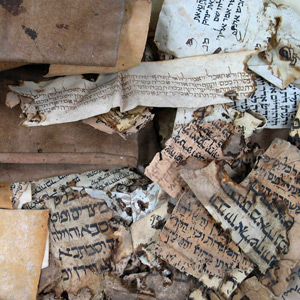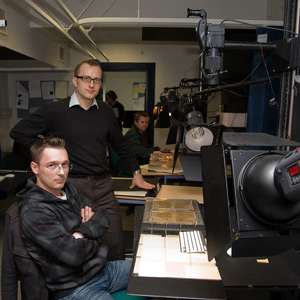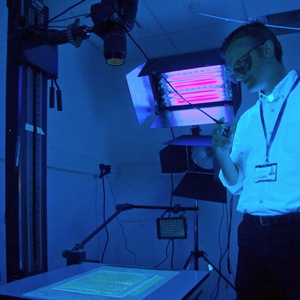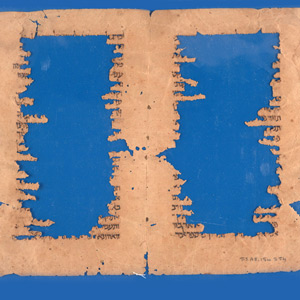World of manuscripts
-
The Cairo Genizah

The Taylor-Schechter Genizah Collection is a priceless accumulation of centuries-old Hebrew manuscript material and Judaica, recovered from the Cairo Genizah in 1896-97. It has occupied a place of honour among the literary treasures of the University of Cambridge for more than a century and is housed at Cambridge University Library.
The Collection was the gift in 1898 of the noted scholar Dr Solomon Schechter - who later became President of the Jewish Theological Seminary of America - and his friend and patron, Dr Charles Taylor, Master of St. John's College, Cambridge.
In 1896 Mrs. Lewis and Mrs. Gibson showed some leaves of a Hebrew manuscript which they had purchased in the Middle East to Schechter, then Reader in Talmudic and Rabbinic literature at Cambridge. He then conceived the idea of bringing to the University the precious manuscript material he suspected could be found in the Genizah (depository for worn-out copies of sacred Jewish writings) of the thousand-year-old Ben Ezra Synagogue of Fostat (Old Cairo). Taylor, an enthusiastic student of Hebrew, joined him in his effort to add to the knowledge of Jews and Judaism, and made it financially possible out of his own means.
In a now famous expedition, Schechter journeyed to Cairo and secured the approval of the Synagogue authorities to 'empty' the Genizah. He chose what seemed to be its most promising material and sent it on to England for scholarly study. Although some fragments had already found their way elsewhere his haul was destined to become by far the most important.
The 140,000 fragments of documents and texts now at Cambridge are mainly in manuscript, many of them on vellum. They include a wide variety of secular as well as religious material and are written in several languages. Although they were gathered in less than two months it has taken over a century to preserve, classify and house the greater part of them in a way that makes them easily available for study - and much still remains to be done.
Yet in these hundred years the Taylor-Schechter Collection has already served to usher in a whole new era of Jewish learning. There is hardly an area of Hebrew and Jewish studies that has not been revolutionized by findings that originated in the Genizah Collection.
-
Digitisation

In a windowless set of former darkrooms located in the heart of the Library’s imaging Services Department, a team of five photographers are engaged in one of the largest digitisation projects in Europe. With little more than the constant click of shutters and the occasional rustle of archival polyester emanating from the imaging suite, the dedicated team have so far produced more than 45,000 images of precious medieval Jewish manuscripts, all safely stored away in perpetuity on the University Library’s DSpace@Cambridge digital repository.
The Taylor-Schechter Genizah Collection is one of the University Library’s greatest treasures, more than 190,000 medieval manuscripts recovered from a synagogue storeroom (Genizah) in Egypt. Vast and wide ranging, it holds examples of every kind of written text produced by the Egyptian Jewish community, from the most rare and ancient works of Judaism to the ephemera of everyday life in medieval Cairo. The Friedberg family of Toronto have given a grant of £1 million to enable this remarkable Collection of fragile paper, vellum and papyrus manuscripts to be digitised, and all the images will eventually be freely available online for anyone to examine.
It is estimated that there are more than 310,000 images to shoot in the three years of the project, and the manuscripts themselves range from tiny scraps of paper little bigger than a postage stamp to enormous sections of biblical scrolls more than a metre across. This great variety in material presents challenges to the photographers and their equipment. Thanks to the Library’s investment in some highly specialised photographic equipment, including an archival scanner capable of shooting material up to A1 in size, and the experienced professionalism of the Imaging Services team under the leadership of Maciej Pawlikowski, the project is on schedule, producing thousands of incredibly detailed digital images each and every week.
-
Ultraviolet Photography

Faded or stained manuscripts, frequent in the Genizah, can be difficult to read. Photographing them under ultraviolet light allows much more to be read, as can be seen in the image of the Hexapla fragment, where ultraviolet light reflects more of the faint lower writing of the palimpsest.
-
The making of manuscripts

Scribes living in Islamic lands in the middle ages regularly used the reed pen, made from the reed plant. In the West quill pens were more common, made from feathers. Dry ink would be mixed with water for writing, and the composition of ink again differed between West and East. Either lampblack, collected from the carbon soot of lamps, or soluble iron salt was used, the former producing lettering in eastern manuscripts that today looks light or dark brown, or even red. Iron in the ink can produce severe corrosion, and there is an extreme, if luckily rare, example in the images here: almost the entire text has disappeared as the iron in the ink has oxidised and destroyed the (normally quite robust) paper. It renders identification of the text almost impossible.
The pages would be ruled in preparation for writing along horizontal lines, with vertical boundary lines aiding the production of a visibly uniform text. Typically, in parchment a series of small pin pricks would be made down the sides of a page, and the horizontal lines would be scored across the width of the sheet. Ruling-boards, such as the one displayed here from the Genizah, would have been used for marking up paper sheets.
-
Further reading
- The Cairo Genizah: One Hundred Years of Discovery and Research, Special Issue: Bulletin of the Israeli Academic Center in Cairo 21 (1997)
- Bloom, Jonathan M. (2001) Paper before print : the history and impact of paper in the Islamic world (New Haven ; London : Yale University Press)
- Gutmann, J. et al., An Introduction to Hebrew Manuscripts
- Hoffman, Adina and Peter Cole (2011) Sacred Trash: The Lost and Found World of the Cairo Geniza (Jewish Encounters; Schocken)
- Reif, S. (2000) A Jewish Archive from Old Cairo: The History of Cambridge University’s Genizah Collection (Richmond: Curzon)
- Reif, S., ed. (2002) The Cambridge Genizah Collections: Their Contents and Significance (Cambridge: Cambridge University Press)
- Sirat, C. (2002) Hebrew Manuscripts of the Middle Ages (Cambridge: Cambridge University Press)
Related resources
- Taylor-Schechter Genizah Research Unit
- Genizah Facebook page
- Cambridge University Library
- Faculty of Divinity
- The Subject Centre for Philosophical and Religious Studies
- Princeton University Geniza Project
- Friedberg Genizah Project
- The Rylands Genizah Collection
- Greek Bible in Byzantine Judaism
- Jewish-non-Jewish Relations: Between Exclusion and Embrace. An Online Teaching Resource
- The Institute of Microfilmed Hebrew Manuscripts